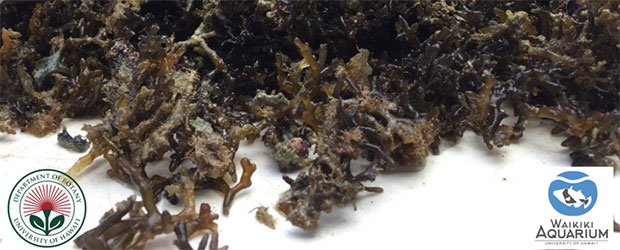Invasive Algae Clean-up

Invasive Algae Removal with Waikiki Aquarium
Wednesday, March 20, 2019
9:00 a.m. – 11:00 a.m.
Waikiki Aquarium
* We ask volunteers to arrive at 8:45am to check-in.
Please join us and help in rehabilitating this iconic Hawaiian landmark – Waikiki Beach!!
Meet by the big Banyan tree behind the back fence of the aquarium (Natatorium side). Look for the tables set up and group gathered. Volunteers can leave backpacks/equipment/etc. along the fence. Do not bring valuables.
Parking can be found around Kapiolani Park or at the Natatorium (not in the Aquarium’s lot). Parking meters begin at 10 am and are 50¢/hr.
What to Bring: Volunteers will want to bring their own tabis or reef shoes, gloves, and even water gear – goggles, mask fins snorkels, towels and reef-safe sunblock…but, you don’t have to go in the water, there are jobs on land.
THE PROJECT
Several species of alien algae have become established on Hawaii’s reefs, and have contributed towards the decline of some reef areas. One such area is the reef fronting the Aquarium, and here efforts have been underway since 2002 to remove these alien species and to restore the reef to its natural condition. Driven by Dr. Celia Smith and her students at the University of Hawaii’s Department of Botany, this Waikiki Aquarium/Botany Department collaboration is a community-oriented project that seeks to remove the alien algae from the reef ecosystem by picking them from the substrate and loading them onshore. Care is taken that any native species inadvertently collected by volunteers is returned to the ocean. The alien algae are weighed, to assess both the scale of the challenge and the effectiveness of the removal efforts, and transported to Honolulu Zoo. There the algae are added to the Zoo’s compost pile, which is used to fertilize the plants on the Zoo grounds and available for public use. At each cleanup, volunteers numbers range from 25 to 90 and represent individuals from throughout the community. All ages are welcome, however minors should be accompanied by an adult at all times.
Outline of activities:
- Cleanup started around 9:00 a.m. with an introduction and overview of the native limu and alien seaweeds for the assembled group of volunteers
- Volunteers loaded burlap bags/Buckets into big wheeled trash cans and used the ramp to bring algae up from the reef
- Once at the sidewalk level, the algae was drained for about 5 minutes and then sorted through the biomass
- Invasive biomass was then weighed and weight recorded
- Weighed biomass was dumped into the back of a truck parked nearby at the cul de sac, by the banyan
- Once filled, the truck went across the street to the zoo, and biomass was added to their compost pile
Register for this free event on eventbrite.
Support the Aquarium
Contact Us
Honolulu, HI 96815
(808) 923-9741
Search
- Already a Volunteer?
- Click Here To Sign In


 Donate
Donate
